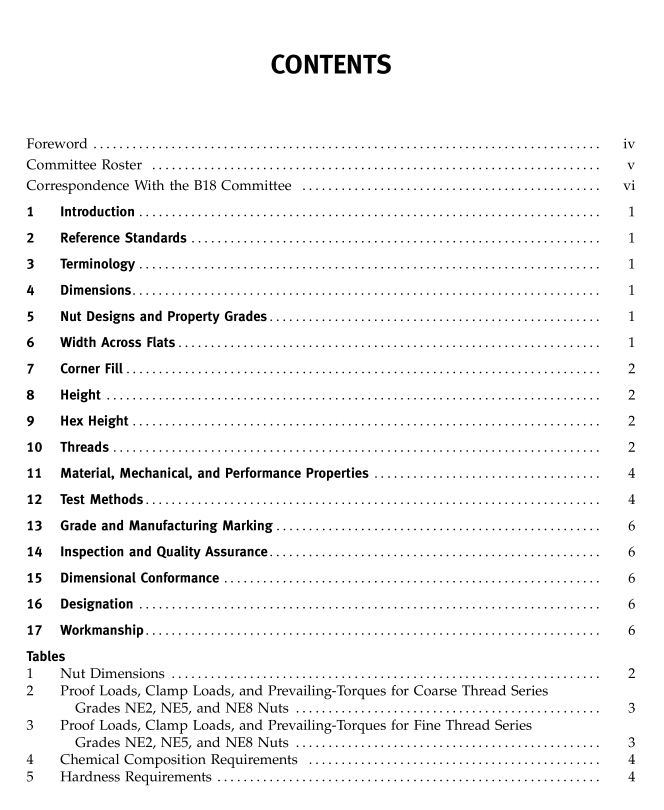ASME B18-16.6 pdf download

ASME B18-16.6 pdf download Nylon Insert Locknuts (Inch Series)
12.1.1 TestBolt. The boltused forproofload testing a nut shall have threads conforming to Class 2A toler- ances as specified in ASME B1.1. The test bolt shall have a yield strength in excess of the specified proof load of the nut being tested.
12.1.2 Hardened Mandrel. The hardened mandrel used for proof load testing a nut shall have threads conforming to Class 3A tolerances as specified in ASME B1.1, except that the major diameter shall be the minimum major diameter with a plus tolerance of 0.002 in. The mandrel shall be heat treated to a hardness of Rockwell C45 to C50.
12.2 Hardness Test The Rockwell hardness of a sample nut shall be deter- mined on the top face of the nut. The top surface of the nut shall be prepared by grinding and removing sufficient material from the top to eliminate the effects of plating, coating, or other surface conditions. Material removal shall also be such as to provide a flat area large enough to allow a hardness test to be made midway between the hex corner and the major diameter of the thread. The bearing surface of the nut shall be prepared parallel to the test surface with removal of plating or coating. Further preparation of the test specimen and the method of performing the test shall conform to ASTM E 18. For referee purposes, nut hardness shall be taken on a longitudinal sectionthrough the nutaxis withreadings taken as close as possible to the nominal major diameter of the nut thread.
12.3 Prevailing-Torque Test The prevailing-torque test shall be conducted at room temperature using a load measuring device (see para. 12.3.2). A test bolt (see para. 12.3.3) and/or hard- ened mandrel (see para. 12.1.2) shall be inserted in the load measuring device, and hardened washer (see para. 12.3.4) placed on the bolt or mandrel and the sam- ple nut then assembled on the bolt or mandrel. The nut shall be advanced until a minimum of three and a maximum of five full bolt or mandrel threads protrude through the top of the nut. At that time, the maximum torque shall be recorded. This torque shall not exceed the first installed prevailing-torque value as specified for the applicable grade and thread series in Table 2 or 3. The torque measuring device shall be in accordance with para.
12.3.1. Tightening shall be continued until the nut is seated against the hardened washer.
The length of the test bolt or mandrel should be such that seating of the nut shall occur at or before a length equivalent to a maximum of nine thread pitches ofthe testboltormandrel protruding through the top of the nut, as measured from the end of the bolt or mandrel. The nut shall then be tightened until a tensile load equal to the clamp load, as specified 5 for the applicable grade and thread series in Table 2 or 3 is developed in the bolt or mandrel. The hardened washer shallbe preventedfromturningduringnuttight- ening. The nutshall thenbe backed offbythe application of reverse torque until the tensile load in the bolt or mandrel has been reduced to zero. The lowest numerical torque occurring while the nut is being backed off throughoutthe next360 deg ofrotation shall be recorded as the minimum first removal torque. This minimum torque shall not be less than the first removal prevailing- torque value as specified in Table 2 or 3. The nut shall then be backed off until the prevailing-torque element is disengaged from the bolt or mandrel thread. The nut shall be reassembled and removed four more times. On each reassembly, the nut shall be assembled to the initial firstremoval position butno clamp load shallbe induced in the bolt or mandrel.
The test washer shall not be removed during these additional cycles. At no time during the four additional installations and removals should the prevailing-torque exceed the maximum, first install prevailing-torque value as speci- fied for the applicable grade and thread series in Table 2 or 3. During the fifth removal, the minimum torque occurring while the nut is being backed off throughout the first 360 deg of rotation shall be recorded. The mini- mum torque shall notbe less than the fifthremoval value as specified in Table 2 or 3. Sufficient time shall elapse between torquing cycles to prevent overheating of the test assembly. The speed of installation and removal of the nut shall not exceed 30 rpm and shall be continuous and uniform.
12.3.1 Torque-Measuring Device. The torque- measuring device shall be capable of measuring the torque while the test nut is in motion. Test results may be recorded by an analog or digital device that is capable of forming a permanent record. The measuring system shall have a measurement uncertainty at the point of measurement of ±2%. Test equipment may be handheld or electronic, provided that accuracy and speed restric- tions as noted above are observed. A manual wrench and manual recording device may be used if it meets the above calibration criteria.
12.3.2 Load-MeasuringDevice. The load-measuring device used in the prevailing-torque test shall be an instrument capable of measuring the actual tension induced in the test bolt as the nut is tightened. The device shall be accurate within ±5% of the test clamp load being used. The bolt clearance hole in the backing plate behind the washer shall have the same diameter and tolerance as the test washer.









